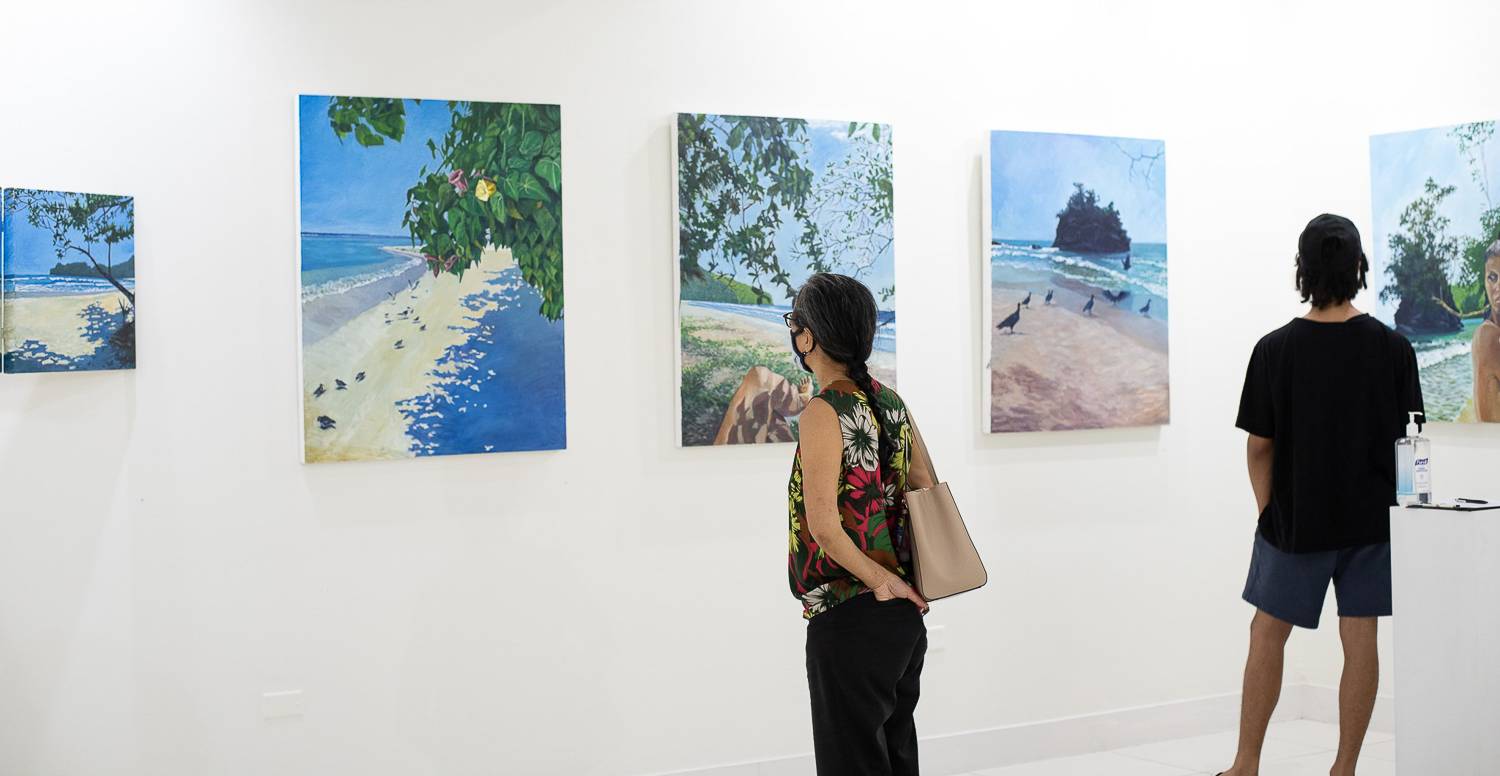
Irénée Shaw
2021
72 x 18” . Polyptych (18 x 18″ each panel)
Oil Painting on Canvas
Irénée Shaw
2021
72 x 18” . Polyptych (18 x 18″ each panel)
Oil Painting on Canvas
Irénée Shaw
2021
72 x 18” . Polyptych (18 x 18″ each panel)
Oil Painting on Canvas
Irénée Shaw
2021
72 x 18” . Polyptych (18 x 18″ each panel)
Oil Painting on Canvas
Irénée Shaw
2021
72 x 18” . Polyptych (18 x 18″ each panel)
Oil Painting on Canvas
Born: 1963, Port of Spain, Trinidad & Tobago. Irénée Shaw is an artist living and working in Trinidad. A figurative painter, the artist has shown her work locally and internationally since her return from study in the United States in 1988. Shaw has done numerous commissions in the Caribbean and also Germany. Most notably the CLICO “Pioneers of the Caribbean” calendar series in 1995. She has participated in the Big River International Workshop, the Santo Domingo Biennial, the Biennial of Cuenca and co-curated Lips Sticks and Marks – an exhibition of contemporary women artists and was a resident at the Vermont Studio Center in 2002. Shaw has taught art at Holy Name Convent, Port of Spain, since 2003

We expect you to sit neatly, to conform; a corner within a corner. But you do not adhere to convention, and instead we are forced to move, to find your centre. The architectural angles and lush vegetation of In d Bamboo, a painting spanning two canvases on hinges, appear both askew and impeccably placed, as they disrupt the established lines of the gallery. Which space speaks of truth? As we shift, the invitation to errantry is brought into focus, but not on our terms. Hands tenderly placed hint at a dialogue which blurs the boundaries of human and natural worlds. It appears that to cross this threshold you must dismantle the hierarchies of ego which place man above all else. Perhaps returning instead to a time when animist beliefs advocated an understanding of the land, in order to understand one’s self.
Irénée Shaw’s most recent body of work, Presence, asks us to examine our relationship to the spaces we inhabit and the imprint we leave in negotiating these landscapes. It encourages a (physical) shifting of perspective, an introspection that considers what was hidden from view in the anarchy of the banal. The everyday that preceded isolation. Created throughout the pandemic, the artist’s work narrates a desire to seek ease in the unease, the land thus becoming a co-conspirator in this search. As the primordial keeper of identity, collective memory, and belonging, our environment shifts intermittently between narrator and protagonist in the story of peoples. These works journey through external and embodied spaces, inviting the viewer to contemplate the healing of seclusion.
Shaw cites the ascent of the camera phone as an artificial appendage, and the ease with which we curate and crop our own image, as having informed her compositional approach. In digital realms, the body is rarely whole, but instead a fragment of itself, echoing only the facets permitted to be seen. Ownership of our bodies is relinquished, and we consent to being dissected, displaced, and dispersed through virtual representation. The artist’s previous works (such as Veils and the Vermont series) dealt with isolation of the female form in similar fashion, for example through recurring motifs of the mouth, exploring the fascination with and oversexualization of certain organs. The emphasis in Presence, however, is the non-invasive language of touch, through the hands and feet, in relation to organic matter. There is a sense that the lethargy and disconnect brought about by enforced physical distancing has been reconciled in these moments of impact with the land; a vessel whose existence we often marginalize, in favour of concrete comforts and the capitalist allure of all that is “man-made”. Shaw asks us to strip away these pretenses and consider how the contours of our own form might adhere to the shape of our surroundings.
Traditional conceptions of focal point are upended in the series of small hinged canvases, which revolt against their linear placement. This intrusion on the path of the observer only serves to remind us that we must deconstruct our notion of perspective, pivoting to apprehend entangled viewpoints. Opulent, dense foliage provides a camouflage for the human presence, in some instances completely obscured as the viewer changes position. Pickin Cocoa depicts a particularly delicate encounter between hand and fruit, both summoning and rejecting resonances of Eden, a theme Shaw has interrogated in past works. Here, an ecosystem is constructed in which the female body can sit in harmony with creation, refusing the legacies of extraction which have characterized our relationship to landscape since the advent of imperial systems.
Many of the works maintain a subtle anonymity through cropping, except for the richly layered portraits of the artist’s daughter. In these, we are able to glimpse the intimacy which only reveals itself in a relationship of complete familiarity. My Moment offers a figure submitting to the elements, as skin is manipulated and shattered by the lace of shadow. These distortions subsume the human form, embracing it as part of the raw, unpretentious surroundings. It speaks to a de-colonial feminism, one which does not ask us to situate our being within the oppressive structures of an industrialized terrain. In a time when women’s bodies (still) endure the omnipresent threat of physical and representational violence, a return to the soil, to water, seems to constitute a radical act. How dare we escape to solitude? To a connection that is not encumbered by this intimidation? As Saidiya Hartman writes, “How does one claim the capacity to touch when touch is, in so many instances, the modality of violence?” In these works, Shaw re-claims this right to touch, to liberation through vulnerability and the reconciliation of self which can take place only in communion with the natural world.
-Shannon Alonzo on Irénée Shaw’s latest body of work.